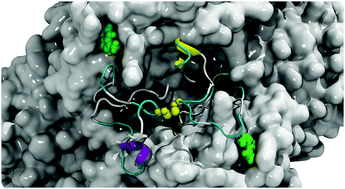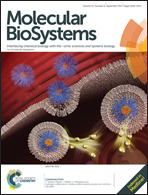Molecular dynamics simulations and in vitro analysis of the CRMP2 thiol switch†
Abstract
The collapsin response mediator protein CRMP2 (gene: DPYSL2) is crucial for neuronal development. The homotetrameric CRMP2 complex is regulated via two mechanisms: first by phosphorylation and second by the reduction and oxidation of the Cys504 residues of two adjacent subunits. Here, we have analysed the effects of this redox switch on the protein in vitro combined with force field molecular dynamics (MD). Earlier X-ray data reveal the structure of the rigid body of the molecule but lack the flexible C-terminus with the important sites for phosphorylation and redox regulation. An in silico model for this part was established by replica exchange simulations and homology modelling, which is consistent with the CD spectroscopy results of the recombinant protein. Thermofluor data indicated that the protein aggregates at bivalent ion concentrations below 200 mM. In simulations the protein surface was covered under these conditions by a large number of ions, which most likely prevent aggregation. A tryptophan residue (Trp295) in close proximity to the forming disulphide allowed the measurement of the structural relaxation of the rigid body upon reduction by fluorescence quenching. We were also able to determine the second-order rate constant of CRMP2 oxidation by H2O2. The simulated solvent accessible surface of the hydroxyl group of Ser518 significantly increased upon reduction of the disulphide bond. Our results give the first detailed insight into the profound structural changes of the tetrameric CRMP2 due to oxidation and indicate a tightly connected regulation by phosphorylation and redox modification.



 Please wait while we load your content...
Please wait while we load your content...